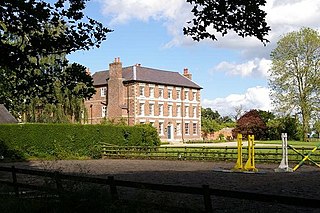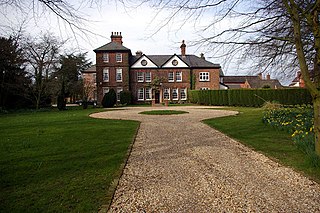
In the early 18th century the Oulton Estate was home to the Egerton family and comprised a manor house and a formal garden surrounded by farmland in Cheshire, England. Later in the century the farmland was converted into a park. The estate is now the site of the motor racing track called Oulton Park.

Tilstone Fearnall is a village and former civil parish, now in the parishes of Tiverton and Tilstone Fearnall and Rushton, in the Cheshire West and Chester district and ceremonial county of Cheshire in England. In 2001 it had a population of 99, increasing to 150 at the 2011 census. The civil parish was abolished in 2015 to form Tiverton and Tilstone Fearnall, part also went to Rushton.
Bexton Hall is a country house in the village of Bexton to the southwest of Knutsford, Cheshire, England. It is a square, symmetrical house of five bays, dating from the late 17th century. It is constructed in brick, with slate roofs, and has two storeys plus a basement. The house is recorded in the National Heritage List for England as a designated Grade II* listed building, and is the only listed building in Bexton parish. The forecourt walls are included in the listing. The house originally had a cupola, but this is no longer present.

Bulkeley Hall is a country house to the southwest of the village of Bulkeley, Cheshire, England. It dates from the middle of the 18th century, and was built for Thomas Bulkeley. The house is constructed in brick with a slate roof. Its architectural style is Georgian. The entrance front has three storeys, and is in seven bays. A service wing at right-angles gives it an L-shaped plan. The interior contains 18th-century plasterwork and joinery. The house is recorded in the National Heritage List for England as a designated Grade II* listed building.
Bulkeley Grange is a country house to the southeast of the village of Bulkeley, Cheshire, England. It replaced an earlier timber-framed house on the site, Bulkeley Old Hall, built by Thomas Brassey in about 1600. Bulkeley Grange was built in about 1865 by his successor and namesake, the railway contractor Thomas Brassey for his brother, Robert Brassey, as a model farm. The house is constructed in red brick with slate roofs in Jacobean style. Some half-timbering has been applied to the exterior. The entrance front is in two storeys and three bays with gables. It has a large, mainly stone, projecting porch with Jacobean-style pilasters and an openwork parapet. The house is recorded in the National Heritage List for England as a designated Grade II listed building.

Crabwall Manor is a former country house, later a hotel, in the village of Mollington, Cheshire, England. The present building dates from the 18th century. It replaced an early 17th-century house built for the Gamul family. The house was originally a "modest brick cottage" and it was refaced in the early 19th century. Figueirdo and Treuherz comment that this give it "the appearance of a toy fort". The interior was remodelled in about 1900. It has since been converted into a hotel, with extensions added in 1987. It is constructed in orange and yellow brick with red sandstone dressings. The roof is in Welsh slate and there are three brick chimneys. The building is in two storeys, with an entrance front of three bays. At the corners are octagonal towers. The central bay protrudes and forms a two-storey porch; it is supported by diagonal buttresses. The tops of the porch and towers are crenellated. The building is recorded in the National Heritage List for England as a designated Grade II listed building.

Davenham Hall is a former country house to the southeast of the village of Davenham, Cheshire, England. It was built for Thomas Ravenscroft to replace a timber-framed house called Davenham Lodge. It dates from the middle or the later part of the 18th century, possibly from shortly before 1795, when Ravenscroft died. Substantial additions were made in the early 19th century. It is constructed in stuccoed brick, and has a slate roof. The house is in two storeys with a symmetrical entrance front of six bays. Occupying the middle two bays is a porch with four Tuscan columns and an entablature containing a triglyph. Above this, the central bays protrude slightly forwards and contain two windows, with a pediment above them and a parapet on each side. Figueirdo and Treuherz describe the interior as being "especially fine". The entrance hall contains Grecian plasterwork and a black marble chimneypiece. The drawing room has more delicate plasterwork, and a marble chimneypiece decorated with dancing figures. The central staircase hall is lit by a central dome, and has fan-shaped plasterwork. The staircase has a wrought iron baluster, and the first floor landing has a screen of four Doric columns. The house was converted into a nursing home in 1980. It is recorded in the National Heritage List for England as a designated Grade II* listed building.

Heawood Hall is a country house, now divided into three houses, southwest of the village of Nether Alderley, Cheshire, England. It originated in the late 17th century; a tall wing was added in the 18th century. Further alterations were made in 1899, and again in the 20th century. It is constructed in red brick with buff sandstone dressings, and is roofed with Welsh slate. Figueirdo and Treuherz describe it as "a complicated and disjointed-looking house". The three houses are named Heawood Chase, Heawood Hall and Heawood House. The building as a whole is recorded in the National Heritage List for England as a designated Grade II listed building.

Ollerton Hall is a country house in the village of Ollerton, Cheshire, England. Its nucleus dates from the 17th century, originally on an H-plan, followed by a succession of "rambling extensions". A plaque over the entrance is inscribed with the initials THP" and the date 1728. The house was built originally for the De Baguley family. The building is constructed in rendered brick with a slate roof. It is in two storeys and, with the later extensions, has an E-plan. The entrance front has five bays, the central bay projecting forward with a gable. At each end is a gabled cross wing. The windows are a mixture of sashes and casements. The house is recorded in the National Heritage List for England as a designated Grade II listed building.
Oughtrington Hall was a country house located in Oughtrington Lane to the east of the village of Lymm in Cheshire, England.

Soss Moss Hall is a former manor house in the parish of Nether Alderley, Cheshire, England. It was built in 1583 for Thomas Wyche. The architectural writers Figueirdo and Treuherz consider that, because of duplication of some of the timbers, it was built in two stages. Between 1835 and 1940 the kitchen of the house was used as Nether Alderley Methodist Chapel. The house was extended in the early 17th century and alterations were made during the 20th century. It is a timber-framed building on a sandstone plinth, with some repairs in brick. The infill is partly with brick, and partly with plaster. It is roofed in Kerridge stone slate, with stone ridges. The house has a H-shaped plan. It has two storeys, the north front having three gables, all of which have black-and-white herringbone decoration. On the left side is a massive stone chimney with three stacks, serving three fireplaces; it contains garderobes. The house is recorded in the National Heritage List for England as a designated Grade II* listed building.
Tattenhall Hall is a country house standing to the south of the village of Tattenhall, Cheshire, England. The house is designated by English Heritage as a Grade II* listed building.
Willaston Hall is a country house in the village of Willaston, near Nantwich, in the unitary authority of Cheshire East, England.

St Jude's Church is on Nantwich Road in Tilstone Fearnall, in the civil parish of Tiverton and Tilstone Fearnall, Cheshire, England. It is an active Anglican parish church in the deanery of Malpas, the archdeaconry of Chester, and the diocese of Chester. Its benefice is combined with that of St Boniface, Bunbury. The church is recorded in the National Heritage List for England as a designated Grade II listed building. It stands opposite the end of the drive leading to Tilstone Lodge.
Huxley is a former civil parish, now in the parishes of Hargrave and Huxley and Tattenhall and District, in Cheshire West and Chester, England. It contains four buildings that are recorded in the National Heritage List for England as designated listed buildings. Two of these are listed at Grade II*, the middle grade, and the other two are at the lowest grade, Grade II. Apart from the village of Huxley, the parish is entirely rural. The listed buildings consist of a former manor house on a moated site, a bridge across the moat, a farm building, and a canal bridge.
Tilstone Fearnall is a former civil parish, now in the parishes of Tiverton and Tilstone Fearnall and Rushton, in Cheshire West and Chester, England. It contains nine buildings that are recorded in the National Heritage List for England as designated listed buildings, all of which are listed at Grade II. This grade is the lowest of the three gradings given to listed buildings and is applied to "buildings of national importance and special interest". Apart from the village of Tilstone Fearnall, the parish is rural. The Shropshire Union Canal passes through the parish, and three of the listed building are associated with it, a bridge, a lock, and a linkman's hut. The other listed buildings include a church, a vicarage, a former mill, and houses and associated structures.
Dawpool was a country house in the village of Thurstaston, Wirral, Merseyside, England. It was built for the shipowner Thomas Henry Ismay in 1882–86 and designed by Richard Norman Shaw. Ismay died in 1899, the family moved out of the house in 1907, and it was demolished in 1927. Parts of the house were re-used in other buildings. Two buildings associated with the house, a lodge and the stables, have survived and are listed buildings.

Astle Hall is a former country house house located near Chelford, Cheshire in the North West of England. The hall has been demolished; its parkland and a lodge survive.









